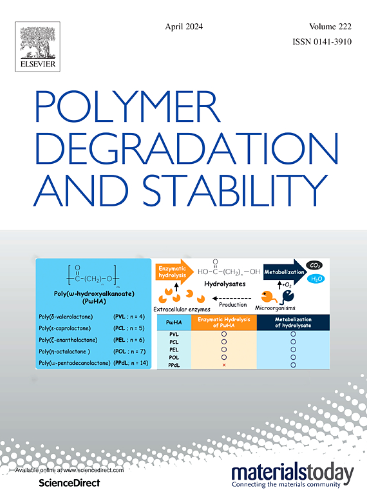通过 COOH 功能化和芬顿化学解构碳-碳键聚合物以进行生物转化
IF 6.3
2区 化学
Q1 POLYMER SCIENCE
引用次数: 0
摘要
对于不能轻易回收利用的碳质废料,通过解构和随后将分解产物生物转化为燃料、化学品或中间体来实现升级再循环是一种很有前景的策略。然而,解构某些重要类型的废塑料(如聚烯烃和聚苯乙烯)以及木质素需要裂解碳-碳键。我们的研究表明,在含有羧酸(COOH)基团的聚合物中,碳-碳骨架键可以通过芬顿反应高效裂解。对于聚丙烯酸这种模范水溶性聚合物,在 pH 值为 4 时,单体只需加入 2 摩尔当量的 H2O2,分子量就会从 Mp = 28,000 g/mol 降至 Mp < 700 g/mol。对该方法进行了改进,在螯合剂介导的芬顿(CMF)反应中加入了二羟基苯,从而大大提高了解构效率。对于酸数为 35(或每 114 个 C 原子中含有 1 个 COOH)的样品,9.5% +/- 0.6% 的碳以水溶性物质的形式被回收,随后的丙酮萃取又回收了 13%。对水溶性化合物的质谱分析表明,大多数低分子量片段形成了三个系列,每个系列的成员因 CH2 单元的数量而异。该系列包含羧酸和醇基团。以这种基质为唯一碳源,测试了一系列微生物的生长情况,根据 600 纳米波长下培养物的光密度测量,有几种微生物表现出良好的生长态势。在没有进一步添加碳源或氮源的情况下,Rhodococcus ruber 和 Brevundimonas vesicularis 在聚乙烯分解产物上生长良好,而在有胰蛋白胨存在的情况下,Bacillus megaterium、Yarrowia lipolytica MYA 2613、Sphingopyxis witflariensis 和 Sphingomonas PWE1 以及 Rhodococcus ruber 和 Brevundimonas vesicularis 在聚乙烯分解产物上生长良好。本文讨论了利用这种方法提高整体转化率的几种思路。本文章由计算机程序翻译,如有差异,请以英文原文为准。
Deconstruction of carbon-carbon bonded polymers for biological conversion through COOH-functionalization and Fenton chemistry
For carbonaceous waste materials that cannot be readily recycled, upcycling through deconstruction and subsequent biological conversion of the breakdown products to fuels, chemicals, or intermediates is a promising strategy. However, deconstructing certain important types of waste plastics such as polyolefins and polystyrene, and also lignin, requires cleaving carbon-carbon bonds. We show that carbon-carbon backbone bonds can be cleaved efficiently by a Fenton reaction in polymers that contain carboxylic acid (COOH) groups. For polyacrylic acid, a model water-soluble polymer, decrease in molecular weight from Mp = 28,000 g/mol to Mp < 700 g/mol occurred with H2O2 loading of only 2 molar equivalents to monomer at pH 4. This method was then applied to partially deconstruct two commercial oxidized polyethylene (oxPE) wax samples with much lower density of COOH groups. A modification of the method, in which dihydroxybenzene was included for a chelator-mediated Fenton (CMF) reaction, greatly increased the deconstruction efficiency. For a sample with acid number of 35 (or ∼ 1 COOH per 114 C atoms), 9.5 % +/- 0.6 % of the carbon was recovered as water-soluble species and an additional 13 % was recovered with subsequent acetone extraction. Mass spectrometry analysis of the water-soluble compounds revealed that most of the low molecular weight fragments form three series, where the members of each series differ by the number of CH2 units. The series contains carboxylic acid and alcohol groups. A panel of microorganisms was tested for growth on this substrate as sole carbon source and several organisms showed promising growth as measured by optical density of cultures at 600 nm. Rhodococcus ruber and Brevundimonas vesicularis grew well on the PE breakdown products with no further carbon or nitrogen sources added whereas Bacillus megaterium, Yarrowia lipolytica MYA 2613, Sphingopyxis witflariensis, and Sphingomonas PWE1 along with Rhodococcus ruber and Brevundimonas vesicularis grew well on the PE breakdown products in the presence of tryptone. Several ideas are discussed to improve the overall conversion with this approach.
求助全文
通过发布文献求助,成功后即可免费获取论文全文。
去求助
来源期刊

Polymer Degradation and Stability
化学-高分子科学
CiteScore
10.10
自引率
10.20%
发文量
325
审稿时长
23 days
期刊介绍:
Polymer Degradation and Stability deals with the degradation reactions and their control which are a major preoccupation of practitioners of the many and diverse aspects of modern polymer technology.
Deteriorative reactions occur during processing, when polymers are subjected to heat, oxygen and mechanical stress, and during the useful life of the materials when oxygen and sunlight are the most important degradative agencies. In more specialised applications, degradation may be induced by high energy radiation, ozone, atmospheric pollutants, mechanical stress, biological action, hydrolysis and many other influences. The mechanisms of these reactions and stabilisation processes must be understood if the technology and application of polymers are to continue to advance. The reporting of investigations of this kind is therefore a major function of this journal.
However there are also new developments in polymer technology in which degradation processes find positive applications. For example, photodegradable plastics are now available, the recycling of polymeric products will become increasingly important, degradation and combustion studies are involved in the definition of the fire hazards which are associated with polymeric materials and the microelectronics industry is vitally dependent upon polymer degradation in the manufacture of its circuitry. Polymer properties may also be improved by processes like curing and grafting, the chemistry of which can be closely related to that which causes physical deterioration in other circumstances.
 求助内容:
求助内容: 应助结果提醒方式:
应助结果提醒方式:


